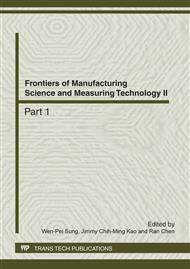[1]
Yan Jiwang, Zhou Tiangfeng, et al. Shape transferability and microscopic deformation of molding dies in aspherical glass lens molding press. Journal of Manufacturing Technology Research, 2009, 1(2009): 85-102.
Google Scholar
[2]
Jain A, Yi A Y. Finite element modeling of structural relaxation during annealing of a precision molded glass lens. Journal of Manufacturing Science and Engineering, 2006, 128(3): 683-690.
DOI: 10.1115/1.2163362
Google Scholar
[3]
Yin Shaohui, Zhu Kejun, Wang Yufang, et al. Numerical Simulation on Two-step Isothermal Glass Lens Molding. Advanced Materials Research, 2010, 126(128), 564-569.
DOI: 10.4028/www.scientific.net/amr.126-128.564
Google Scholar
[4]
Tsai Y C, C. Hung J, Hung C. Glass material model for the forming stage of the glass molding process. Journal of Materials Processing Technology, 2008, 201: 751-754.
DOI: 10.1016/j.jmatprotec.2007.11.294
Google Scholar
[5]
Zhou H M, Xi G D, Li D Q. Modeling and simulation of shrinkage during the picture tube panel forming process. Journal of Manufac- turing Science and Engineering, ASME, 2007, 129(2): 380–387.
DOI: 10.1115/1.2673274
Google Scholar
[6]
Masahide K. Transferability of glass lens molding. Proceedings of SPIE, 2006, (6149): 61490M1-9.
Google Scholar
[7]
Hyre M. Numerical simulation of glass forming and conditioning. Journal of the American Ceramic Society, 2002, 85 (5), 1047-1056.
DOI: 10.1111/j.1151-2916.2002.tb00221.x
Google Scholar
[8]
Ananthasayanam B. Computational modeling of precision molding of aspheric glass optics. Clemson University, (2008).
Google Scholar


